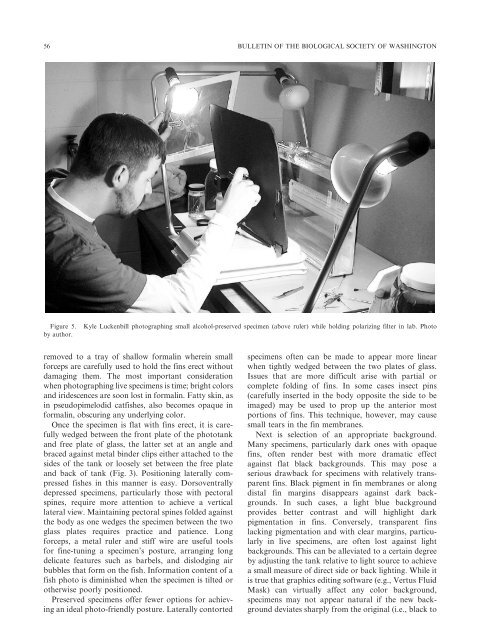Biological Society of Washington - Department of Botany ...
Biological Society of Washington - Department of Botany ...
Biological Society of Washington - Department of Botany ...
You also want an ePaper? Increase the reach of your titles
YUMPU automatically turns print PDFs into web optimized ePapers that Google loves.
56 BULLETIN OF THE BIOLOGICAL SOCIETY OF WASHINGTON<br />
Figure 5. Kyle Luckenbill photographing small alcohol-preserved specimen (above ruler) while holding polarizing filter in lab. Photo<br />
by author.<br />
removed to a tray <strong>of</strong> shallow formalin wherein small<br />
forceps are carefully used to hold the fins erect without<br />
damaging them. The most important consideration<br />
when photographing live specimens is time; bright colors<br />
and iridescences are soon lost in formalin. Fatty skin, as<br />
in pseudopimelodid catfishes, also becomes opaque in<br />
formalin, obscuring any underlying color.<br />
Once the specimen is flat with fins erect, it is carefully<br />
wedged between the front plate <strong>of</strong> the phototank<br />
and free plate <strong>of</strong> glass, the latter set at an angle and<br />
braced against metal binder clips either attached to the<br />
sides <strong>of</strong> the tank or loosely set between the free plate<br />
and back <strong>of</strong> tank (Fig. 3). Positioning laterally compressed<br />
fishes in this manner is easy. Dorsoventrally<br />
depressed specimens, particularly those with pectoral<br />
spines, require more attention to achieve a vertical<br />
lateral view. Maintaining pectoral spines folded against<br />
the body as one wedges the specimen between the two<br />
glass plates requires practice and patience. Long<br />
forceps, a metal ruler and stiff wire are useful tools<br />
for fine-tuning a specimen’s posture, arranging long<br />
delicate features such as barbels, and dislodging air<br />
bubbles that form on the fish. Information content <strong>of</strong> a<br />
fish photo is diminished when the specimen is tilted or<br />
otherwise poorly positioned.<br />
Preserved specimens <strong>of</strong>fer fewer options for achieving<br />
an ideal photo-friendly posture. Laterally contorted<br />
specimens <strong>of</strong>ten can be made to appear more linear<br />
when tightly wedged between the two plates <strong>of</strong> glass.<br />
Issues that are more difficult arise with partial or<br />
complete folding <strong>of</strong> fins. In some cases insect pins<br />
(carefully inserted in the body opposite the side to be<br />
imaged) may be used to prop up the anterior most<br />
portions <strong>of</strong> fins. This technique, however, may cause<br />
small tears in the fin membranes.<br />
Next is selection <strong>of</strong> an appropriate background.<br />
Many specimens, particularly dark ones with opaque<br />
fins, <strong>of</strong>ten render best with more dramatic effect<br />
against flat black backgrounds. This may pose a<br />
serious drawback for specimens with relatively transparent<br />
fins. Black pigment in fin membranes or along<br />
distal fin margins disappears against dark backgrounds.<br />
In such cases, a light blue background<br />
provides better contrast and will highlight dark<br />
pigmentation in fins. Conversely, transparent fins<br />
lacking pigmentation and with clear margins, particularly<br />
in live specimens, are <strong>of</strong>ten lost against light<br />
backgrounds. This can be alleviated to a certain degree<br />
by adjusting the tank relative to light source to achieve<br />
a small measure <strong>of</strong> direct side or back lighting. While it<br />
is true that graphics editing s<strong>of</strong>tware (e.g., Vertus Fluid<br />
Mask) can virtually affect any color background,<br />
specimens may not appear natural if the new background<br />
deviates sharply from the original (i.e., black to
















